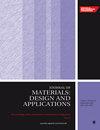涂有石墨粉的传统硅基传感器和辅助硅基传感器的多向压阻情景比较研究
IF 2.2
4区 材料科学
Q3 MATERIALS SCIENCE, MULTIDISCIPLINARY
Proceedings of the Institution of Mechanical Engineers, Part L: Journal of Materials: Design and Applications
Pub Date : 2024-04-13
DOI:10.1177/14644207241247236
引用次数: 0
摘要
以硅酮 RTV2 为基材,涂上石墨粉作为传感元件,对传统传感器和辅助传感器的多向压阻情况进行了(比较)研究。比较的关键参数是施加应变后增加的面积。该参数越大,传感元件的分离面积就越大,灵敏度也就越高。要在三向模式下进行传感性能测试,一种低成本的方法是使用卡盘车床和电动机周期性地打开和关闭卡盘板条。数值研究使用了现有的商业软件 ABAQUS2021。对传统传感器和辅助传感器在不同加载模式下的灵敏度测试表明,辅助传感器在单向和双向加载模式下的性能分别比传统传感器好 272% 和 130%。这说明,如果两个传感器的添加面积更接近,其传感性能会更接近。虽然两个传感器在三向加载模式下的传感性能几乎相同,但传统传感器变形所需的应变能是辅助传感器的 30 倍。本文章由计算机程序翻译,如有差异,请以英文原文为准。
A comparative study on the multidirectional piezo-resistive scenario of conventional and auxetic silicone-based sensors coated with graphite powder
The (comparative) study on the multidirectional piezo-resistive scenario of conventional and auxetic sensors is presented using silicone RTV2 as a base material coated with graphite powder as a sensing element. The key parameter of this comparison is the added area that appeared by applying the strain. The larger this parameter is, the larger the area for the sensing elements separation, and subsequently, the greater the sensitivity. To do the sensing performance test in a three-directional mode, a low-cost idea is to use a chuck lathe and an electric motor to open and close the chuck lath cyclically. The available commercial software ABAQUS2021 is used for numerical study. The sensitivity test on conventional and auxetic sensors in different loading modes shows that the performance of the auxetic sensor in unidirectional and bidirectional loading modes is 272% and 130% better than the conventional sensor, respectively. It means that if the added area for the two sensors is closer to each other, the sensory performance of the two sensors will be more similar. Although the sensing performance of the two sensors in the three-directional loading mode is almost equal, the consumed strain energy required to deform the conventional sensor is 30 times more than that of the auxetic one.
求助全文
通过发布文献求助,成功后即可免费获取论文全文。
去求助
来源期刊

CiteScore
4.70
自引率
8.30%
发文量
166
审稿时长
3 months
期刊介绍:
The Journal of Materials: Design and Applications covers the usage and design of materials for application in an engineering context. The materials covered include metals, ceramics, and composites, as well as engineering polymers.
"The Journal of Materials Design and Applications is dedicated to publishing papers of the highest quality, in a timely fashion, covering a variety of important areas in materials technology. The Journal''s publishers have a wealth of publishing expertise and ensure that authors are given exemplary service. Every attention is given to publishing the papers as quickly as possible. The Journal has an excellent international reputation, with a corresponding international Editorial Board from a large number of different materials areas and disciplines advising the Editor." Professor Bill Banks - University of Strathclyde, UK
This journal is a member of the Committee on Publication Ethics (COPE).
 求助内容:
求助内容: 应助结果提醒方式:
应助结果提醒方式:


